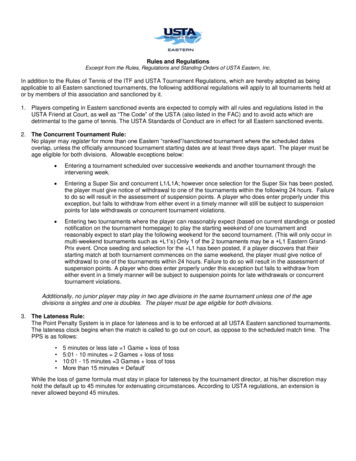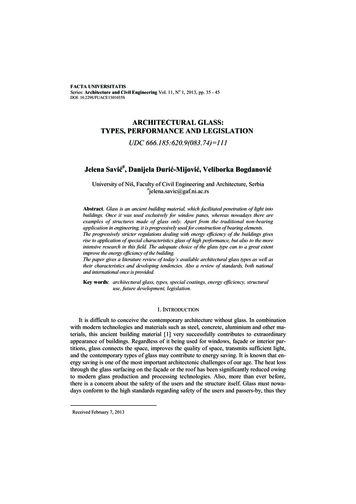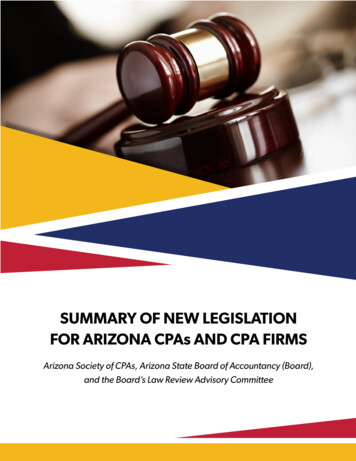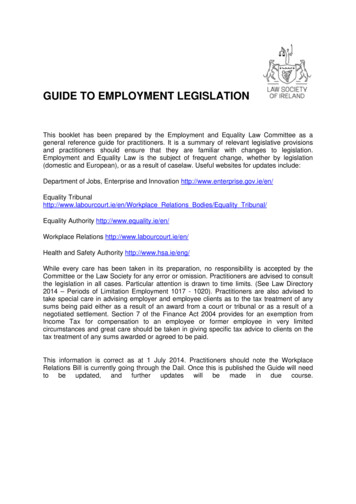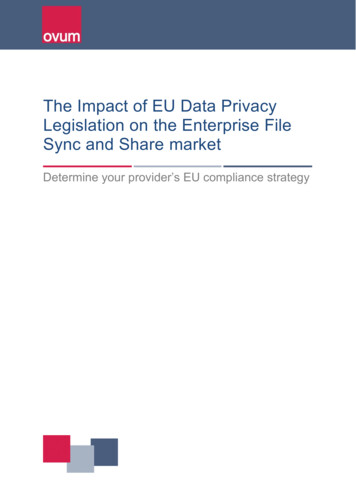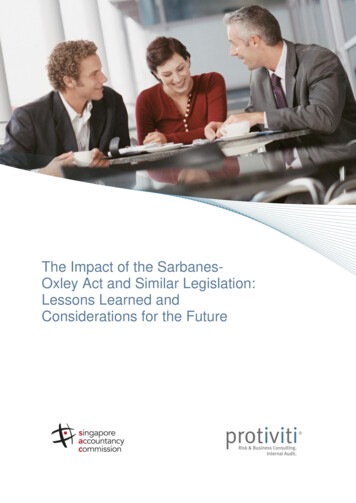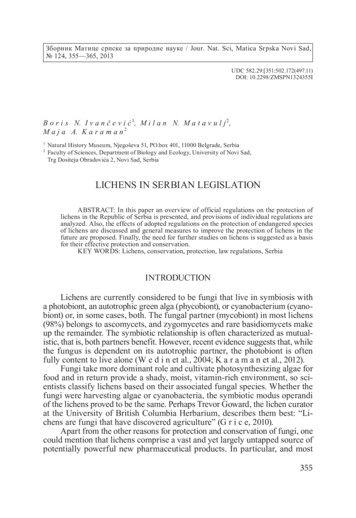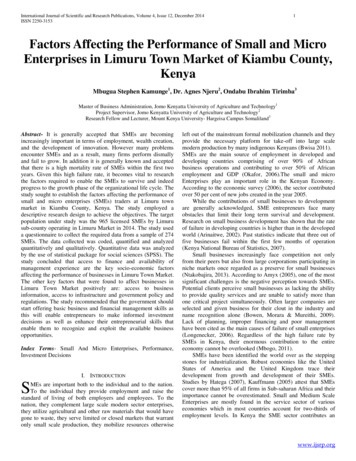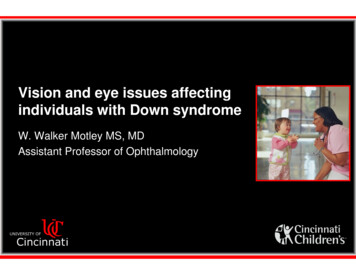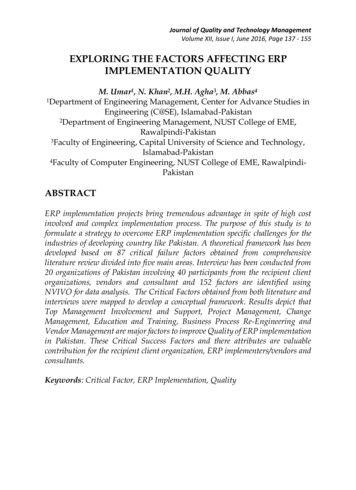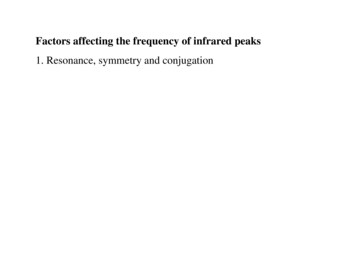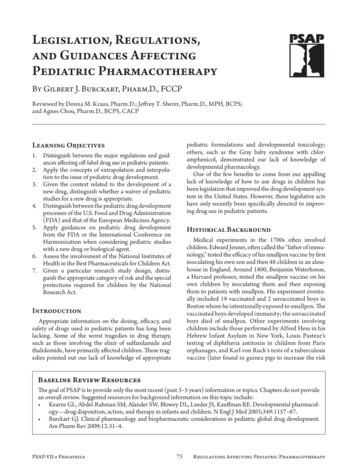
Transcription
Legislation, Regulations,and Guidances AffectingPediatric PharmacotherapyBy Gilbert J. Burckart, Pharm.D., FCCPReviewed by Donna M. Kraus, Pharm.D.; Jeffrey T. Sherer, Pharm.D., MPH, BCPS;and Agnes Chou, Pharm.D., BCPS, CACPLearning Objectivespediatric formulations and developmental toxicology;others, such as the Gray baby syndrome with chloramphenicol, demonstrated our lack of knowledge ofdevelopmental pharmacology.One of the few benefits to come from our appallinglack of knowledge of how to use drugs in children hasbeen legislation that improved the drug development system in the United States. However, these legislative actshave only recently been specifically directed to improving drug use in pediatric patients.1. Distinguish between the major regulations and guidances affecting off-label drug use in pediatric patients.2. Apply the concepts of extrapolation and interpolation to the issue of pediatric drug development.3. Given the context related to the development of anew drug, distinguish whether a waiver of pediatricstudies for a new drug is appropriate.4. Distinguish between the pediatric drug developmentprocesses of the U.S. Food and Drug Administration(FDA) and that of the European Medicines Agency.5. Apply guidances on pediatric drug developmentfrom the FDA or the International Conference onHarmonization when considering pediatric studieswith a new drug or biological agent.6. Assess the involvement of the National Institutes ofHealth in the Best Pharmaceuticals for Children Act.7. Given a particular research study design, distinguish the appropriate category of risk and the specialprotections required for children by the NationalResearch Act.Historical BackgroundMedical experiments in the 1700s often involvedchildren. Edward Jenner, often called the “father of immunology,” tested the efficacy of his smallpox vaccine by firstinoculating his own son and then 48 children in an almshouse in England. Around 1800, Benjamin Waterhouse,a Harvard professor, tested the smallpox vaccine on hisown children by inoculating them and then exposingthem to patients with smallpox. His experiment eventually included 19 vaccinated and 2 unvaccinated boys inBoston whom he intentionally exposed to smallpox. Thevaccinated boys developed immunity; the unvaccinatedboys died of smallpox. Other experiments involvingchildren include those performed by Alfred Hess in hisHebrew Infant Asylum in New York, Louis Pasteur’stesting of diphtheria antitoxin in children from Parisorphanages, and Karl von Ruck’s tests of a tuberculosisvaccine (later found in guinea pigs to increase the riskIntroductionAppropriate information on the dosing, efficacy, andsafety of drugs used in pediatric patients has long beenlacking. Some of the worst tragedies in drug therapy,such as those involving the elixir of sulfanilamide andthalidomide, have primarily affected children. These tragedies pointed out our lack of knowledge of appropriateBaseline Review ResourcesThe goal of PSAP is to provide only the most recent (past 3–5 years) information or topics. Chapters do not providean overall review. Suggested resources for background information on this topic include: Kearns GL, Abdel-Rahman SM, Alander SW, Blowey DL, Leeder JS, Kauffman RE. Developmental pharmacology—drug disposition, action, and therapy in infants and children. N Engl J Med 2003;349:1157–67. Burckart GJ. Clinical pharmacology and biopharmaceutic considerations in pediatric global drug development.Am Pharm Rev 2009;12:31–4.PSAP-VII Pediatrics73Regulations Affecting Pediatric Pharmacotherapy
concluded that more than 70% of all drugs listed in thePhysicians’ Desk Reference were not labeled for use inpediatric patients.Around that time, a regulatory approach to correctthe lack of pediatric drug studies and information available was devised. In 1994, the FDA had requested thatsponsors provide all available drug information on theuse of their drugs in pediatric patients. The intent of thisaction was to allow labeling of drugs for use in pediatricpatients if sufficient scientific information was available.However, the program was unsuccessful in obtainingsufficient information for most drugs.In 1997, the FDA Modernization Act (FDAMA)included an incentive for sponsors whose drugs werestudied in pediatric patients. If the sponsors performedpediatric studies, they received an extra 6 months ofpatent exclusivity for their drug. Biologics were not eligible for the program, but all other investigational andapproved drugs could receive the extra patent life. In2002, these incentives were renewed under the BestPharmaceuticals for Children Act (BPCA).In 1998, the National Institutes of Health (NIH) published the NIH Policy and Guidelines on the Inclusionof Children as Participants in Research InvolvingHuman Subjects. Also that year, the FDA promulgated the Pediatric Rule requiring all Biologic LicenseApplications, new drug applications (NDAs), and supplemental applications to include pediatric safety andeffectiveness data. The Pediatric Rule was enforced ifthe application had a new active ingredient, indication,dosage form, dosage regimen, or route of administration. The studies conducted under the Pediatric Rulewere also eligible for the patent extension provided bythe FDAMA. Therefore, the FDA’s pediatric programprovided both a requirement and a financial incentiveto meet this requirement.In 2000, the Association of American Physicians andSurgeons, the Competitive Enterprise Institute, andConsumer Alert sued the FDA, claiming the agencydid not have the legislative authority to enforce thePediatric Rule. In 2002, a federal court in Washington,D.C., struck down the Pediatric Rule. Then-Secretaryof Health and Human Services Tommy G. Thompsonimmediately worked with Congress to codify the basictenets of the Pediatric Rule. In 2003, Congress enactedthe Pediatric Research Equity Act (PREA) to ensurethat new drugs intended for use in children would bestudied in children.Historically, the FDA has put considerable emphasis on labeling for pediatric uses; this is not because ofthe regulatory process of labeling but because of the evidentiary standards required by the FDA to substantiatelabeling,. Under these legislative acts, pediatric studiesare performed and drugs are labeled for use in pediatricpatients; therefore, the off-label use of drugs in pediatricpatients is one measure of success of these acts. EveryAbbreviations in This ChapterBPCACFRFDAAAFDAMAICHIRBNDAPPSRPREABest Pharmaceuticals forChildren ActCode of Federal RegulationsFDA Amendment Act of 2007FDA Modernization Act of 1997International Conference onHarmonizationInstitutional Review BoardNew drug applicationProposed Pediatric StudyRequestPediatric Research Equity Actof contracting tuberculosis) in children at an orphanagein North Carolina. As recently as the 1950s and 1960s,research on hepatitis used mentally retarded children atWillowbrook State School in New York.Eventually, the pendulum swung the other way, andchildren were excluded from drug development programs, thus preventing the specific study of drugs inpediatric patients. In 1968, Dr. Harry Shirkey createdthe term therapeutic orphans to describe this situation.The lack of drug studies in children created a systemin which pediatricians had to make difficult decisionsabout the risks, and benefits of using a drug in a childwhen no information on dosing, efficacy, or safety in thepediatric population was available. That lack of information was reflected by the absence of pediatric dosinginformation in U.S. Food and Drug Administration(FDA)-approved labeling, which meant these drugswere being used off-label. At the time of Shirkey’s declaration, about 80% of all drugs had no labeled indicationsfor use in pediatric patients.The research in children at Willowbrook, togetherwith other excesses in adults such as the Public HealthService’s syphilis trials, eventually led to the passage in1974 of the National Research Act. This act establishedthe National Commission for the Protection of HumanSubjects of Biomedical and Behavioral Research. Thenext 30 years saw the creation of pediatric clinical pharmacology as a discipline.Prominent pediatric physicians and pharmacistsworked to establish a pharmacokinetic basis for drugdosing in children, laying the groundwork for understanding the ontogeny of drug metabolism and the renalelimination of drugs in pediatric patients. A growingconcern was that, although the National Research Actsubpart D protected children as human research subjects, it might provide a reason to exclude children fromresearch trials. By 1998, little progress had been madein developing sufficient information for the FDA tolabel drugs specifically for pediatric use. A 1999 reportRegulations Affecting Pediatric Pharmacotherapy74PSAP-VII Pediatrics
clinician realizes that most drugs are used off-label (i.e.,for indications for the pediatric population not includedin FDA-approved labeling). Although information onthe efficacy and safety of many drugs has been developed through studies, many of these pediatric off-labeluses still lack adequate information on pediatric dosing,efficacy, and safety.discusses the potential use in pediatric patients, acurrent understanding of the risk/benefit ratio in pediatric patients, and whether studies should be waived ordeferred in any age group. If the application meets oneof the five criteria described above under the PediatricRule, the requirements of the PREA are activated andmust be followed. If the pediatric assessment concludesthat pediatric studies are to be deferred until after adultapproval, then a pediatric plan is required for deferredpediatric studies. Otherwise, pediatric studies meetingthe PREA requirements should be submitted before theapproval of the adult application.Under Title IV of the FDAAA, tracking of studiesunder the PREA and BPCA is required, together withdata on labeling changes produced under these legislativeacts. The complete medical, statistical, and clinical pharmacology reviews for pediatric submissions under theBPCA and PREA are available on the FDA Web site. Anannual review of all studies under the PREA is now conducted and publicly available. An FDA Pediatric ReviewCommittee was established that reviews all applications to ensure they fulfill the requirements of the PREAbefore approval. The FDA Pediatric Review Committeeis a multidisciplinary group composed in part of pediatricians from the Pediatric and Maternal Health Staff,FDA Center for Drug Evaluation and Research; of pediatricians of the Office of Pediatric Therapeutics, FDACommissioner’s Office; and of pediatric clinical pharmacologists and pharmacometricians from the FDA Officeof Clinical Pharmacology.The pediatric plan to perform deferred studies afteradult approval is a postmarketing requirement. This is incontrast to a postmarketing commitment, which is notconsidered a requirement. Before a drug’s approval foruse in adults, the pediatric plan should be complete andbased on modeling and simulation of all available data forthe drug.Important Regulations Relatedto Pediatric Drug TherapyNational Research ActThe National Commission for the Protection ofHuman Subjects of Biomedical and Behavioral Researchwas formed by the passage of the National Research Act in1974. One of the commission’s charges was to identify therequirements for informed consent to participate in biomedical or behavioral research in children. The resulting1977 report, Research Involving Children, was translatedinto regulations as 45 Code of Federal Regulations (CFR)46 (subpart D) – Additional Protections for Children asResearch Subjects.According to the commission’s report, research in children would be classified according to the risk and benefitto the child participating. As the risk-to-benefit ratio ofthe research became less favorable for the participatingchild, additional protections would be needed. These categories were written into sections 45 CFR 46.404–407 ofsubpart D of the regulations. Research involving minorsmust fit into one of four risk categories to be approved byan Institutional Review Board (IRB); Table 1-1 lists theserisk categories, along with their definitions, examples,and special considerations. In addition, section 45 CFR46.409 restricts the involvement of wards of the state inresearch that entails greater than minimal risk and that iswithout direct subject benefit.For a child to participate in research, consent (permission) of one or both parents is required, dependingon the risk assessment; also required, in most cases, isassent (agreement) of the child. According to 45 CFR46.401, merely failing to object should not be construedas assent. Not all children are capable of giving assent; thelocal IRB is responsible for determining the age of assentand when assent is an absolute requirement. A waiver ofconsent or assent is possible in studies approvable underCFR 46.404 (minimal risk) but not for studies in theother categories.Best Pharmaceuticals for Children ActThe BPCA, which was also extended for 5 years underthe FDAAA, is scheduled to expire on October 1, 2012.The NIH plays a large role in the BPCA because when theFDA issues a written request for drug studies in childrenunder the BPCA, and the written request is not acceptedby the sponsor, the NIH considers funding the studies.Most of the drugs considered by the NIH are off-patent,so no patent exclusivity could be gained by conductingpediatric studies. The NIH annually conducts a BPCAmeeting that brings together several pediatric constituencies and sets priorities for NIH funding of pediatricstudies for the coming year. The NIH works closely withthe FDA and submits Proposed Pediatric Study Requests(PPSRs) to the FDA for consideration.A PPSR can also be submitted to the FDA by the sponsor developing a new drug. In this case, the sponsor hasa financial incentive to perform the pediatric studies inPediatric Research Equity ActThe PRE
Regulations Affecting Pediatric Pharmacotherapy 74 PSAP-VII Pediatrics of contracting tuberculosis) in children at an orphanage in North Carolina. As recently as the 1950s and 1960s, research on hepatitis used mentally retarded children at Willowbrook State School in New York. Eventually, the pendulum swung the other way, and children were excluded from drug development pro-grams, thus .
